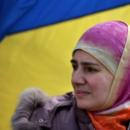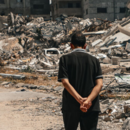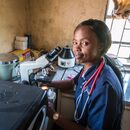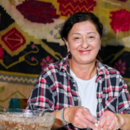It is probable that the Syrian crisis will negatively affect the Jordanian economy for many years. The local economy had problems before the start of the conflict in Syria, but the arrival of hundreds thousands of refugees significantly deepened the existing problems.
"Regardless of the quantity of aid that flows into the country, the impact of the Syrian crisis on the Jordanian economy will be huge,” says a leading Jordanian economist Khalid Kazan. Currently, the serious discussion, how to protect the Jordanian economy from the consequences of this crisis, does not take place. Each Syrian refugee will increase the burden of Jordan's budget by $ 3,000 and annual costs associated with the stay of one million refugees will exceed 3 billion. "We'll be able to measure the impact on infrastructure and education first in 10 years," said Kazan and added that the quality of education will deteriorate due to overcrowded classes.
Due to the influx of refugees, the rate of population growth has increased threefold - from 2.2% to 6.6%. The number of Syrians registered with UHNCR in Jordan is more than 600,000, which is 8% of the entire local populations. Furthermore, in the country of more than 500,000 other Syrians refugees without registration. Of the total number of registered refugees, only 125,000 of them are living in refugee camps. The rest are spread about in towns and villages across the country, which further increases the demands on infrastructure and affects the employment opportunities for Jordanians.
Regarding ages of Syrian refugees - 80% are under 35 years of age and 40% are younger than 11 years. Khalid Kazan concludes that the refugee crisis is particularly burdensome for the education system, health facilities and infrastructure. At the same time, the labour market situation is getting worse because the Syrians take jobs from the Jordanians.
The above-mentioned problems are not just focused in Amman, home to the largest number of refugees (around 150,000 people). Also in Zarqa region, where there are 100,000 refugees, it is increasing the annual cost of security (currently two million Jordanian dinars). A similar situation is also in Jerash, north of Amman, which is currently about 60,000 refugees.
Even the local infrastructure, environment and health and education systems must face increased stress. Moreover, other problems have emerged in some northern regions - such as the lack of flour in bakeries due to the large consumption of bread. Similar situations raise worries about conflicts between different population groups.
Refugees living in these areas urgently need to repair their makeshift homes, gain access to clean water, hygiene supplies and cash. Meanwhile, angry complaints on restrictions of services provided by local and international organizations is heard from some areas in the region of Irbid in northern Jordan (where there are about 14,000 Syrian refugees) - despite many visits and promises that were made. While the Syrians in neighbouring areas (Jerash and Ajloun) regularly receive cash and material assistance.
Governmental and non-governmental institutions are slowly running out financial and technical resources and therefore cannot adequately respond to the considerable needs of local residents. This leads to enormous protests and vocal expressions of dissatisfaction due to the shortcomings in the provision of basic services.
In this context it should be noted that the basis for successful mitigation of the impact of the humanitarian crisis is the involvement of the world community. Of the $ 2.3 billion that were promised at the donors' conference in Kuwait in January 2014, the donor countries provided about 45% (as of April 2014). Kyung-wha Kang, Deputy UN humanitarian affairs said, "Timely funding is essential for cost-effective security of uninterrupted supply of aid".
Although many countries are actively involved in solving problems, humanitarian programs for Syria and the entire region remain severely underfunded. Humanitarian organizations working in Syria and in countries with a Syrian refugee population received only 20% of the $ 6.5 billion that will be needed in 2014. UN and other organizations need to constantly seek ways to guarantee the remaining 5.3 billion.







